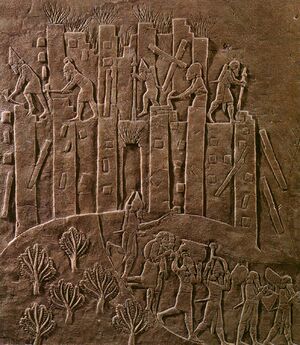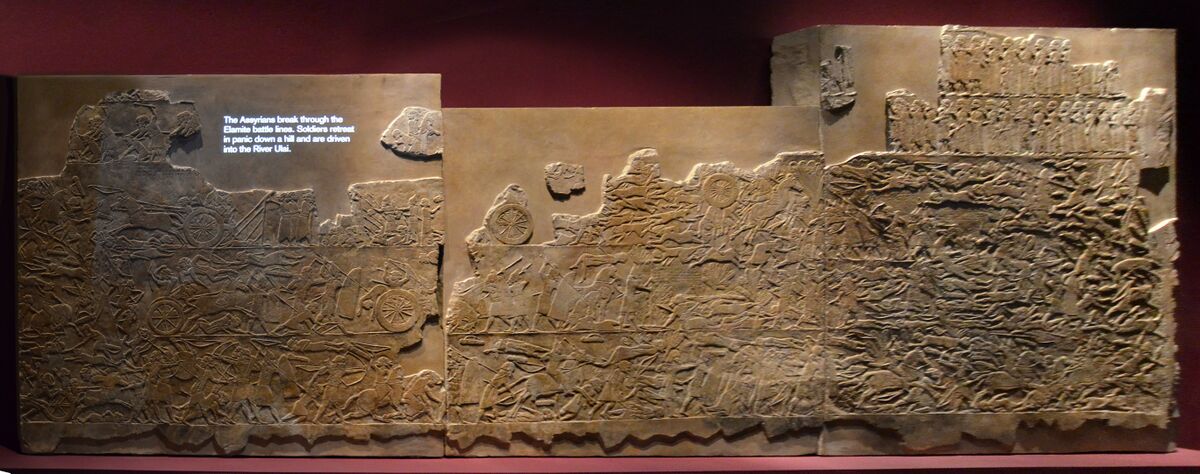الفتح الآشوري لعيلام
| الفتح الآشوري لعيلام | |||||||
|---|---|---|---|---|---|---|---|
| جزء من حروب آشور الجديدة | |||||||
 حملة آشوربانيپال على عيلام is triumphantly recorded in this relief showing the destruction of the city of Hamanu. Here, flames rise from the city as Assyrian soldiers topple it with pickaxes and crowbars and carry off the spoils. 645-635 BCE. British Museum BM 124919.[1] | |||||||
| |||||||
| المتحاربون | |||||||
| الإمبراطورية الآشورية الحديثة | عيلام | ||||||
| القادة والزعماء | |||||||
|
الملك آسرحدون الملك آشوربانيپال | الملك Teumman † | ||||||
| القوى | |||||||
| غير معروفة | غير معروفة، يُفترض أنها كانت في البداية مساوية للخصم قبل الانهيار | ||||||
| الضحايا والخسائر | |||||||
| غير معروفة | العديد من المدنيين والجنود | ||||||
فتح عيلام على يد الإمبراطورية الآشورية الحديثة وقع بين عامي 655 و 639 ق.م..
خلفية
Clashes between the Elamites and the Assyrians had been ongoing for many years prior to 721 BC, the first recorded conflict between Elamites and Assyrians. For many centuries before that, the Elamites had made it a habit of intervening in Babylonian politics. Naturally this would have placed them in conflict with the Assyrians, who saw Babylon as within their sphere of influence. In 721 BC, the Babylonians rebelled against Assyria and Elamite forces attempted to aid Babylon in her revolt. Following this event, the Assyrians and Elamites clashed on numerous occasions; at the Tigris in 717 BC, along the Elamite coast as part of an amphibious invasion in 694 BC, at the province of Der and again at the River Diyala in 693 BC (this may have been the same battle). For the most part, these battles were bloody and inconclusive. However, the Assyrians were able to obtain the upper hand for the most part, demonstrated by the failure of the Elamites to extend their power beyond the boundaries of Mesopotamia.
After a failed attack on Babylon in 655 BC, Elamite power soon began to collapse. At the Battle of Ulai in the plain of Susa, an Assyrian army assaulted strong Elamite defensive positions. The Elamites were soundly beaten and Teumman, the Elamite king, was beheaded during the battle. Although another Babylonian revolt saved Elam from immediate invasion, it would remain one of the most important objectives in the mind of Assurbanipal.
الحملة على عيلام
In 648 BC, the Elamite city of Susa was razed to the ground; it was to be a terrible portent of events to come. In 639 BC, the Assyrians moved their entire army from the west to destroy their enemies.
انهيار عيلام
The defeats inflicted by Assyria on Elamite offensives were one of many problems facing the Elamites; civil war had erupted in the land, whilst her northern borders were being overrun by the Persians. In 639 BC, Assurbanipal moved into Elam and proudly documented the vengeance against Elamite incursions:
For a distance of a month and twenty-five days' journey I devastated the provinces of Elam. Salt and sihlu I scattered over them... The dust of Susa, Madaktu, Haltemash and the rest of the cities I gathered together and took to Assyria... The noise of people, the tread of cattle and sheep, the glad shouts of rejoicing, I banished from its fields. Wild asses, gazelles and all kinds of beasts of the plain I caused to lie down among them, as if at home.
— Ashurbanipal[2]
With Elam destroyed, the Assyrians returned to find their empire falling apart; years of war had destroyed their ability to wage it. Within 34 years of Elam's destruction, Assyria fell as an independent political entity in the Middle East forever.
انظر أيضاً
المراجع
- ^ "Wall panel; relief British Museum". The British Museum (in الإنجليزية).
- ^ Healy, Mark (1991). The Ancient Assyrians. New York: Osprey. p. 54.
- ^ "Wall panel; relief British Museum". The British Museum (in الإنجليزية).
